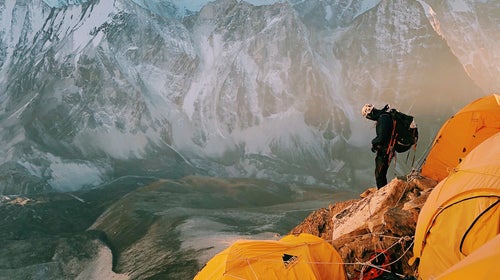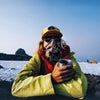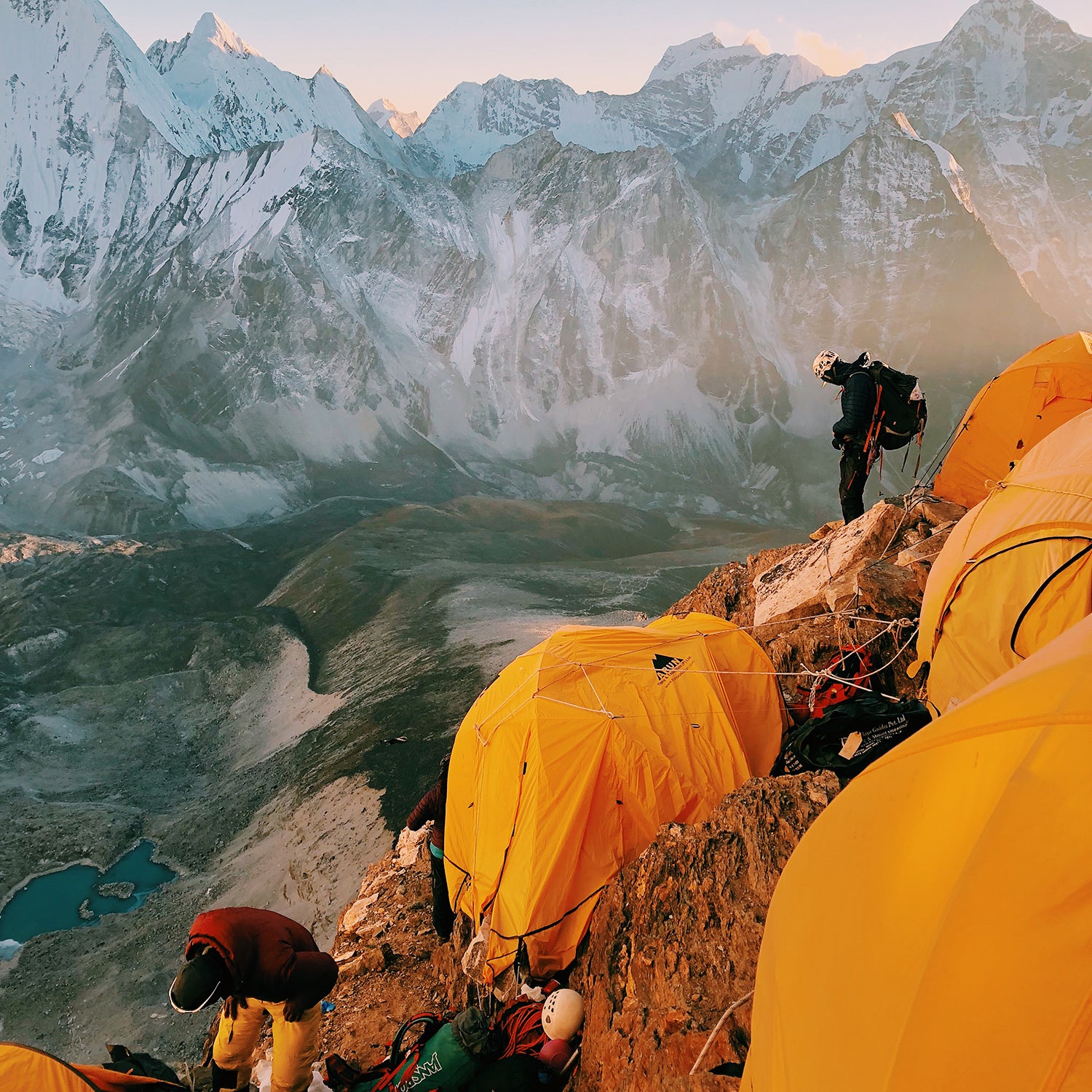Ama Dablam sits in the heart of Nepal’s Khumbu Valley, just a few days’ walk from Mount Everest. Trekkers heading to Everest Base Camp will spend the better part of two days staring at its 22,349-foot summit. From the trails that snake through the valley, it looks foreboding, dramatic, improbable.
The first time I really saw Ama Dablam was on Google Images—a��shark’s fin of rock capped by a swath of steep snow runnels leading to the mountain’s apex. Pictures of tents precariously perched at camp two��are basically designed to give your grandpa a hernia. Footage distorted by GoPro’s infamous fish-eye lens renders ridgelines perilous tightropes at 20,000 feet.
“I want to climb that one,” my boyfriend and climbing partner, Mike, said last spring. The idea kind of made me want to throw up, which was how I knew I was going to say yes.��A few days earlier we’d had a few too many beers and impulse-bought cheap flights to Nepal for the coming fall. We hired a logistics company to handle our porters and base-camp support, but Mike is a professional mountain guide, so we planned to��climb on our own. After a few months spent ironing out details, we wired a large sum of money to the company��and finally hopped a flight to Kathmandu in mid-October.
The type-A part of my personality comes out aggressively before I do anything big. Before running the Leadville 100 in 2017, I spent weeks fine-tuning a detailed four-page Google doc for my support crew. My Ama Dablam doc was 19 pages long. I’m inclined to be embarrassed about what that might say about my anal retentiveness, but I consulted it often and found it useful. One thing I read about a lot were accidents on the mountain. I wanted to understand the worst-case scenarios ahead of time.��So, I wondered, when people die on Ama Dablam, what tends to go wrong?
There are any number of ways to die in the mountains. On peaks 6,000 meters��and higher��in Nepal’s Himalayas, death occurs most often by falling��(39 percent), avalanche (28 percent), or acute mountain sickness (7.6 percent). Between 1959 and 2018, 32��people have died attempting the climb on Ama Dablam, according to the Himalayan Database, which keeps track of such things. Fifteen deaths resulted from a fall, five from illness, three from falling rock or ice, seven from avalanches, and one from a failed BASE jump (the cause of one death is unknown). In 2006, the Dablam avalanched.��(The Dablam is a huge hanging glacier that gives the mountain��its name; Ama Dablam means “mother’s necklace.”)��It killed a team of six in their sleep at camp three. That camp has been considered too dangerous to use until recently. Many of the : not testing ropes before committing to them, clipping an old rope instead of a new one, rappelling off the end of a rope, failing to use gear correctly or employ proper safeguards.
None of these things are surprising,��and are easy enough to write off as a cost of doing business in the mountains. You can’t plan your way out of everything. Accidents happen. Objective hazards exist. Was the climber being irresponsible, or were they just unlucky? In this way you can rationalize risk to skeptical family members—and to yourself. You can hang out in the territory between naivete and acceptance, by believing it won’t happen to you while also knowing that it just might.
The trade route on Ama Dablam follows the southwest ridge, a rocky spine that sends climbers up exposed rock faces, around gendarmes, and up mixed couloirs to steep snow and ice pitches that lead to a surprisingly expansive, flat summit. The climbing is varied, and the position is spectacular. Sir Edmund Hillary once called it “unclimbable,” but today it’s one of the country’s most frequently permitted peaks. It’d likely still be considered unclimbable for most mountaineers if not for the climbing Sherpas��who fix ropes from camp one��to the summit at the beginning of every season.��Ropes or not, though, the margin for error on Ama Dablam is close to zero. The exposure is huge, and there’s almost always a few thousand feet of air beneath your boots.��
You can hang out in the territory between naivete and acceptance,��by believing it won’t happen to you while also knowing that it just might.
You can’t control objective hazards, but you can control your own preparation. To that end, I spent the spring and summer fine-tuning skills. I did practice laps at the climbing gym while simultaneously sliding an ascender, a progress-capture device, up a fixed rope. The point of this was to replicate the peak’s Yellow Tower, a 40-foot rock face that goes��at around 5.8, which some call the technical crux of the climb. Mike and I climbed routes like , a committing��and exposed 3,000-foot route in Washington’s North Cascades that’s steep enough to frequently require two ice tools. For exposure therapy: lots of multipitch rock routes and airy��rappelling. Statistically, most��mountaineering��accidents happen on the descent, when climbers are tired. And to descend Ama Dablam, you’ve got to do at least 20 rappels. I wanted to be able to do it efficiently in my sleep, or in an altitude-induced haze. (We heard a story about climbers leaving the summit��last��fall who’d never rappelled before, if you can imagine.)
We flew to Lukla in October, and after two weeks of trekking, we made it to camp one, at 18,500 feet. The trail there��is a nontechnical slog and can be done in four to five hours. We set up camp on one of the few remaining flattish slivers of dirt amid��a field of boulders. Due to the risk of petty crime (seriously), we padlocked our tent’s doors to protect our water, food, and fuel before returning to base camp to plan our ascent and wait for a weather window.
Camp two��sits on top of a rock pillar that drops off thousands of feet on either side. Real estate is limited.��You can fit��roughly a dozen tents up there, none of which will be comfortable and all of which will be close together. It’s a smelly, high-altitude slumber party. Teams rotate through the tents that are already set up, so individual climbers have to figure out if a tent is free during their desired summit bid. After asking around, we still hadn’t found any openings, and were talking about summiting from camp one��instead, when a pair of Romanians approached us. They offered to sell their Black Diamond Firstlight, which was already pitched at camp two, for way too much money. But it looked like our best option, so we reluctantly forked over the cash. What’s the going rate for a tattered nylon roof on a rocky, off-kilter piece of dirt at 19,700 feet? Two hundred dollars, after a round of hard bargaining. Our Sherpa friends thought this sort of Ama Dablam Airbnb thing was ridiculous, and they had a good laugh about it.
We got to camp two��just before sunset and found our expensive neon green hotel room tied to a small ledge. The ledge cliffed out just a few steps from the front door. It was imperative that we watched our step when going to pee,��or really when doing anything at all. If you’ve never seen a Firstlight, they weigh nothing and are incredibly tiny. Ours pitched left at about 20 degrees, and the two of us��slept more or less in a pile. We waited until all the other climbers left camp so we could climb alone up the Grey Tower, a few loose pitches of blocky 75-degree granite where the route turns from rock to ice and snow.
It’s sections like this where you wouldn’t want someone above you making desperate or careless steps and accidentally knocking down rocks. We had watched��some people learn how to use their gear for the first time at base camp��and so had��a healthy skepticism of other climbers on the mountain. In some instances, we saw climbers approach an anchor and then wait for their Nepali guide to transfer all their safety gear for them. It was impossible to know if the person above you was experienced��or if this was all new. You can’t control other climbers.
We took a quick break to gnaw on frozen Snickers bars just as the sun was starting to coat the surrounding peaks in pink.��From there we ascended a few short ice cliffs to camp three��before continuing up onto the steep snow pitches that led to the summit. A little less than nine hours after leaving camp two,��we stood alone on top, all smiles (and maybe a few tears) with unreal 360-degree views of the tallest peaks in the world.
You can technically do everything right��and that can still not be enough.
To descend, we swapped our ascenders��for belay devices. The terrain on the upper snowfields is less than vertical, maybe 70 degrees, so the rappel is essentially a quick backward��walk downhill. We fell into an easy rhythm, with Mike about one anchor ahead. Maybe five rappels down the snowfields, the fixed line curves back to the right and around a slight corner. Below us was another 1,200 feet of snowfield that flattened out to camp three, followed by a steep face that dropped to the valley floor another 5,000 feet below. Just as I approached the corner, the anchor I was weighting—a single metal picket driven into the snow—blew out. I fell about ten feet, swinging out left before the rope went tight again. I was fine,��but spooked. It’s unnerving to fall suddenly like that in such an exposed position. Luckily, the ropes that make up the fixed lines are mostly all tied both together and to each anchor. Had that not been the case, there’s no way I would’ve been able to arrest that fall. Mike, who has some 50 pounds on me, had just used that same anchor, as did all the people who’d summited before us that day. I was rappelling gently.
During the fall 2018 season, two people died on Ama Dablam. I read about what happened once I’d returned home. Steven Biem, a��47-year-old American, died�� at camp two,��and Australian Michael Davis��died in what was��called a “freak accident” when��rockfall severed the rope . Their deaths don’t seem to be the result of inexperience.��You can technically do everything right��and that can still not be enough.
Reading the news didn’t make me feel like I’d skirted death, even though I’d slept at camp two,��where��Biem had died, and rappelled the same rope below the same rock that killed Davis just ten days after I’d been there. It��only made me feel sorry.��I think most would agree that no mountain is worth dying for, or even worth losing a single fingertip over, but that line of thinking just compels climbers to turn around when it gets too dangerous to continue, and it’s not meant to dissuade them from trying at all. To go and try something challenging that you’re not sure you can do is sort of the whole point.
Death in the mountains, and the deaths on Ama Dablam��last��season, don’t really make me think about mountaineering any differently. Not because I don’t think something like that could ever happen to me, but because I think that it very well could.


